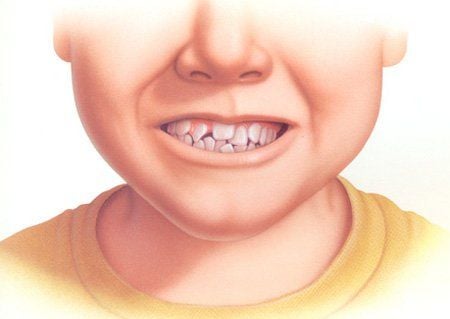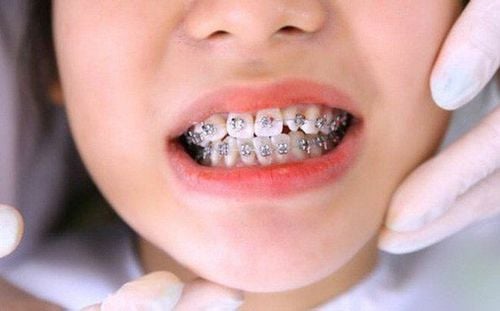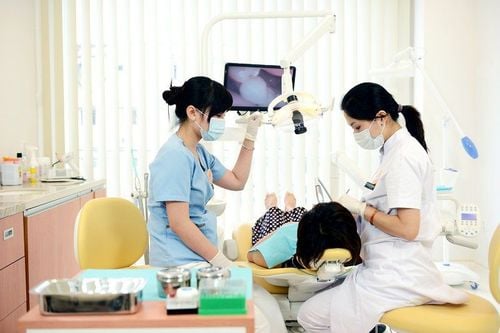This is an automatically translated article.
Grinding incisors is an invasive treatment of tooth tissue to overcome the condition of incisors that are too long, large or chipped, ... This technique is only performed when absolutely necessary and requires the dentist to follow Comply with standards when grinding such as tooth grinding ratio, initial shape of teeth, measures to protect teeth after grinding.
1. What is incisor grinding?
1.1. Features of incisors
Each person has 4 incisors per jaw, including 2 middle incisors and 2 lateral incisors Incisors are the teeth that play a decisive role in the beauty of a smile The pulp contains many blood vessels and nerves The incisors play a major role in biting and tearing food. The enamel thickness is thin, only about 1-2.5mm. 1.2. The process of grinding incisors
Grinding incisors is an invasive method to enamel, in order to overcome the situation of protruding jaws, large, long, chipped incisors, ... to bring harmony to the jaw arch. The advantages of incisor grinding compared to other orthodontic methods are: low cost, less time consuming.
How to grind front teeth: normally, this process will take place in the following order:
Examination and consultation: the patient is checked for the condition of his teeth and advised on the appropriate method. Oral hygiene: clean the patient's oral cavity to ensure sterility. In case the tooth is suffering from a certain disease such as caries, cracked teeth, pulpitis, ... the patient will be treated first, then proceed to grind the teeth. Anesthesia: after the cleaning step, the patient will be anesthetized to ensure no pain. Teeth grinding: the patient will be grinding the front teeth according to the defined standards so as not to invade the tooth pulp. Teeth will be grinded in the order of outer surface, incisal edge, upper surface, inner surface, finishing line. Protecting teeth after grinding: after grinding the front teeth, the patient will be advised on a method to protect the tooth tissue, which is porcelain crown.
2. Some cases need to grind front teeth
Any invasion of tooth tissue causes discomfort to the patient, so only grinding incisors is carried out in the following cases:
Grinding broken or broken incisors: when the front teeth are broken in the direction horizontally, vertically, diagonally, most of the tooth tissue is lost and it is very difficult to fill it up so that the tooth can be restored as well as before. Therefore, the method to be done is to grind the remaining tooth tissue to cover the porcelain teeth and reconstruct the patient's front teeth. Grinding chipped front teeth: for teeth that cannot be restored with fillings, teeth grinding will be indicated to cover porcelain teeth. This method helps to protect the teeth better. Grinding protruding front teeth: will help overcome the protrusion in a short time, no need to wear braces. But in case of severe protrusion or due to bone, it is not possible to grind the front teeth but will have to use other orthodontic methods. Grinding incisors is misaligned and uneven: when the teeth are misaligned, uneven in size, it causes loss of aesthetics and makes the patient less confident, affecting the ability to communicate. Therefore, grinding teeth with misaligned doors is a simple, effective and economical remedy.
3. Standard for grinding front teeth
Improper grinding of front teeth can cause food jams, bad breath and other dental problems. In addition, the manipulation process can lead to invasion of the tooth pulp, making teeth sensitive, sensitive, damaged, affecting chewing, ... Therefore, in order to grind incisors safely and effectively, it is necessary to must comply with the conditions of tooth grinding ratio, initial shape of teeth, measures to protect teeth after grinding.
Non-invasive dentin caries: the allowable grinding ratio with incisors is: 0.6 - 1mm for the neck, 1 - 1.5mm for the crown, 1.2 - 2mm for the biting edge. The original shape of the teeth: it is necessary to ensure that after grinding, the teeth are reshaped in the correct natural shape. Measures to protect teeth after grinding: Porcelain crowns help protect teeth from physical and chemical effects and conceal imperfections on teeth such as teeth that are dull, yellow...
4. Measures to care for front teeth after grinding
After grinding teeth, it is necessary to take good oral care measures to bring good results. You need to note:
Daily oral hygiene with appropriate dental floss and mouthwash. Periodic dental examination and thorough treatment of oral diseases (periodontal disease, tooth decay, ...). Limit eating foods that are hard, flexible, acidic, and dark in color such as coffee, gummy candies, bones, cartilage, etc. Avoid activities and sports that are likely to cause bumps in the mouth area, causing teeth hurt.
5. Some notes when grinding front teeth
Any manipulations that infringe on tooth enamel are not recommended, so only grinding incisors should be performed when absolutely necessary (grinding front teeth with protrusion, deviation, heavy chipping, ...) .
The grinding rate should not exceed 2mm, not invasive to dentin, tooth pulp. Only perform incisor grinding when the teeth are in good health, without other oral problems such as tooth decay, pulpitis, cracked teeth, ...
Above is all the important information about tooth grinding. Therefore, when there is a need to grind teeth or intervene with any orthodontic method, you should go to reputable clinics and medical facilities for examination and appropriate indications.
Please dial HOTLINE for more information or register for an appointment HERE. Download MyVinmec app to make appointments faster and to manage your bookings easily.













